Khajuraho Group of Monuments travel - India, Asia
The Khajuraho Group of Monuments is a collection of Hindu and Jain temples located in Chhatarpur district of Madhya Pradesh, India, about 175 km southeast of Jhansi. The temples were built between 885 CE and 1000 CE by the Chandela dynasty and are famous for their Nagara-style architecture and erotic sculptures.
The monuments are divided into three groups - the Western, Eastern and Southern clusters. At its peak in the 12th century, the site had 85 temples spread over 20 square kilometers. Today, only about 25 temples remain, covering an area of 6 square kilometers. The largest and most famous temple is the Kandariya Mahadeva, decorated with 626 intricate sculptures.
The temples strike a balance between architecture and sculpture, with all surfaces profusely carved with anthropomorphic and non-anthropomorphic motifs depicting sacred and secular themes. The sculptures showcase the artistic mastery of the Chandela era, with delicate, youthful female forms known as 'sura-sundaris' winning universal admiration.
Population: Estimate 25,000 people (as of 2024)
Economy: Tourism is the backbone of Khajuraho's economy, significantly contributing to local livelihoods. The temples attract a large number of domestic and international visitors, making the city one of India's major tourist destinations. The rise in tourism has led to the development of various accommodations, from luxury hotels to budget options, catering to a wide range of travelers. This growth has created numerous job opportunities in hospitality and ancillary services, including guiding, transport, and local crafts.
Landmarks: Kandariya Mahadeva Temple, Lakshmana Temple, Vishvanatha Temple, Parsvanatha Temple, Adinatha Temple, Chitragupta Temple, Jagadambi Temple, Duladeo Temple
India
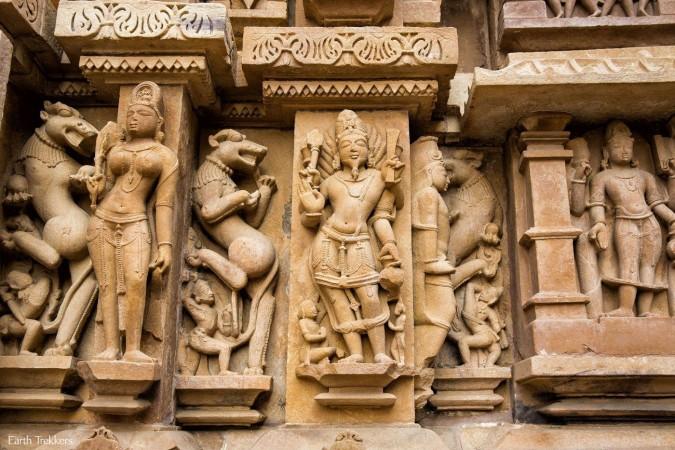
Overview of Khajuraho Group of Monuments
History & Cultural Influence
The Khajuraho Group of Monuments is a remarkable collection of Hindu and Jain temples that showcase the architectural and artistic brilliance of the Chandela dynasty, which ruled central India from the 9th to 12th centuries CE. These temples, built between 885 CE and 1000 CE, have had a profound impact on the history and cultural identity of the region.
Chandela Dynasty: The Khajuraho temples were constructed during the peak of the Chandela dynasty's power, reflecting their wealth, patronage of the arts, and religious devotion. The temples were built about 35 miles from the Chandela capital of Mahoba, in the Kalinjar region.
Architectural Masterpieces: The temples are renowned for their Nagara-style architecture and intricate sculptures, which depict sacred and secular themes. The largest and most famous temple, Kandariya Mahadeva, is decorated with 626 sculptures showcasing the artistic mastery of the Chandela era.
Religious Tolerance: The Khajuraho temples were dedicated to both Hinduism and Jainism, suggesting a tradition of religious acceptance and respect among the Chandelas. This diversity is reflected in the temple sculptures and layout.
Artistic Legacy: The sculptures of Khajuraho, particularly the erotic carvings, have become iconic representations of Indian art and culture. They have inspired generations of artists and continue to fascinate visitors from around the world.
The Khajuraho Group of Monuments is a major tourist attraction, drawing visitors to the region and contributing significantly to the local economy. The temples were designated a UNESCO World Heritage site in 1986, further enhancing their global recognition and cultural significance.
Interaction with The Locals
The majority of the population in Khajuraho belongs to the Bundelkhandi ethnic group, which is native to the Bundelkhand region of central India. They have a distinct culture, language, and traditions. The town also has a significant presence of other ethnic groups, including Hindus from various parts of India, as well as a small Muslim population. The diversity is a result of the town's historical significance and its role as a major tourist destination. The locals in Khajuraho are generally very welcoming and friendly towards tourists. They are used to interacting with visitors from all over the world and are eager to share their culture and traditions.
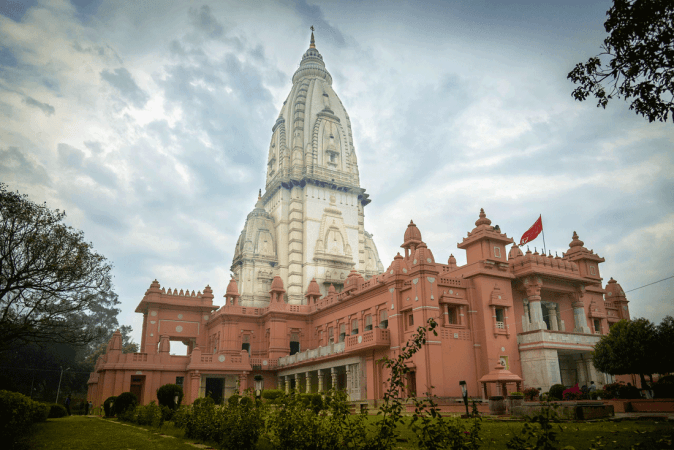
Vishwanatha Temple - © varanasiguru
Top attractions in Khajuraho Group of Monuments
Explore the mesmerizing Khajuraho Group of Monuments, a UNESCO World Heritage site renowned for its stunning temples adorned with intricate carvings that depict scenes of love, mythology, and daily life. These architectural marvels, built showcase the artistry and spiritual heritage of medieval India. A visit to Khajuraho offers a unique blend of history, art, and culture, making it an unforgettable destination for travelers.
Kandariya Mahadeva Temple
Location: Western Group of Temples, Khajuraho, Madhya Pradesh.
Kandariya Mahadeva Temple is the largest and most ornate temple in the Western Group, dedicated to Lord Shiva. It is renowned for its intricate carvings and sculptures depicting various deities, celestial nymphs, and erotic scenes.
Lakshmana Temple
Location: Western Group of Temples, Khajuraho, Madhya Pradesh.
Built in the 10th century, Lakshmana Temple is dedicated to Lord Vishnu and is celebrated for its exquisite sculptures and detailed architectural design. The temple features a stunning depiction of the divine couple, Lakshmi and Vishnu.
Vishwanatha Temple
Location: Vishwanath Gali, in Varanasi, Uttar Pradesh.
Another significant temple in the Western Group, Vishwanatha Temple is dedicated to Lord Shiva. It showcases beautiful carvings and a massive lingam (Shiva's symbolic representation) in its sanctum.
Parsvanatha Temple
Location: Eastern Group of Temples, Khajuraho, Madhya Pradesh.
The largest Jain temple in Khajuraho, Parsvanatha Temple, is dedicated to Lord Parsvanatha. It is known for its serene architecture and detailed carvings that reflect Jain beliefs and values.
Jain Museum
Location: Near the Eastern Group of Temples, Khajuraho, Madhya Pradesh.
The Jain Museum is dedicated to Jain art and culture, housing a collection of sculptures, artifacts, and manuscripts that illustrate the rich heritage of Jainism in the region.
Panna National Park
Location: Near Panna, Madhya Pradesh, approximately 25 km from Khajuraho.
Panna National Park is known for its diverse wildlife, including tigers, leopards, and various bird species. It offers opportunities for nature walks and wildlife spotting.
Raneh Falls
Location: About 20 km from Khajuraho, near the town of Raneh.
Raneh Falls is a picturesque waterfall known for its unique rock formations and scenic beauty. It is a popular spot for picnics and photography.
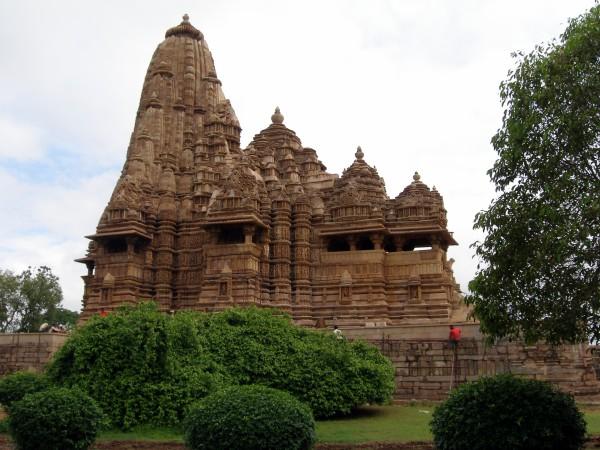
Kandariya Mahadeva Temple - © gather
Must-Try Dishes in Khajuraho Group of Monuments
Delight your taste buds with the authentic flavors of Khajuraho by trying the rich and spicy Bundeli Gosht, a traditional mutton curry known for its robust spices and tender meat. Savor the unique taste of Korma, a creamy and aromatic dish made with a blend of local spices, yogurt, and nuts, offering a taste of the region's royal culinary heritage.
Dal Bafla
Dal Bafla is a traditional dish from the Bundelkhand region, featuring wheat dough balls that are boiled and then roasted over a fire, served with a rich lentil curry (dal) and ghee. This hearty meal is a staple in local cuisine, often enjoyed during festivals and special occasions, showcasing the region's agricultural roots.
Chaat
Chaat is a popular street food, offering a savory mix of boiled potatoes, chickpeas, yogurt, chutneys, and spices, topped with crispy sev (noodles). It embodies the vibrant street food culture of India, delivering a burst of flavors that locals and tourists alike can't resist.
Jalebi
Jalebi is a beloved sweet treat made from fermented batter, deep-fried into circular shapes, and soaked in sugar syrup. Crispy on the outside and syrupy on the inside, this dessert is a festive favorite, symbolizing joy and celebration in the local culture.
Chironji Barfi
Chironji Barfi is a traditional sweet made from chironji nuts, condensed milk, and sugar, often flavored with cardamom and garnished with nuts. This delicacy reflects the region's love for sweets and is a popular gift during festivals.
Ghol
Ghol is a unique dish made from dried fruits, ghee, and jaggery, typically prepared during festivals and special family gatherings. It highlights the use of local ingredients and traditional cooking methods, capturing the essence of Khajuraho's culinary heritage.
Paneer Tikka
Paneer Tikka is a vegetarian dish of marinated paneer cubes, skewered and grilled to perfection, often served with mint chutney. This dish is popular among all food lovers and represents the influence of North Indian cuisine in the region.
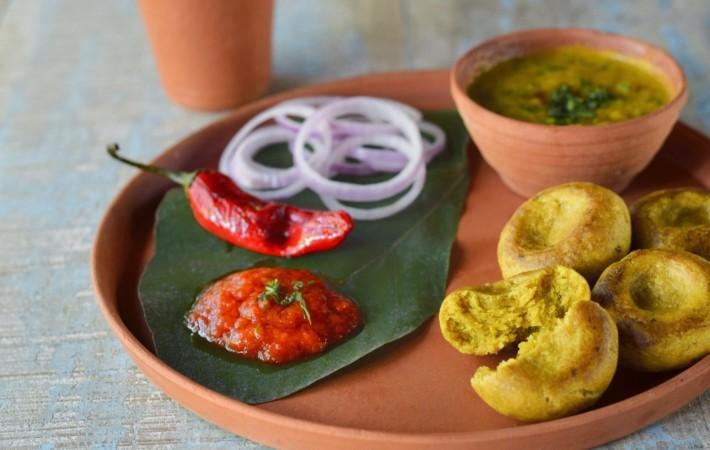
Dal Bafla - © gather
Festivals & Local Celebrations
Khajuraho Dance Festival
Time of Year: Annually from February 20 to February 26
The Khajuraho Dance Festival is a week-long celebration of classical Indian dance forms like Kathak, Bharatanatyam, Odissi, and Kuchipudi. Renowned dancers perform in front of the beautifully lit temples, creating a mesmerizing atmosphere. Visitors can enjoy free entry to these performances held in an open-air auditorium, offering a cultural experience enhanced by the stunning backdrop of ancient monuments.
Mahashivratri
Time of Year: February or March, depending on the lunar calendar
Mahashivratri is dedicated to Lord Shiva and celebrated with great devotion. Devotees gather at the Kandariya Mahadev Temple, where the lingam is adorned with flowers and special rituals are performed. Visitors can witness night-long prayers, hymns, and a festive atmosphere, offering a spiritually enriching experience as locals engage in devotional activities.
Vat Savitri Puja
Time of Year: May or June
Vat Savitri Puja holds significance for married women who fast for the well-being and longevity of their husbands. The town is festively decorated, and women participate in rituals, including tying a sacred thread around a banyan tree. Visitors can observe the local customs and vibrant community spirit during this auspicious occasion.
Diwali
Time of Year: October or November, depending on the lunar calendar
Diwali, the Festival of Lights, is celebrated with great enthusiasm in Khajuraho. The streets and temples are illuminated with diyas (oil lamps) and colorful rangoli designs. Visitors can immerse themselves in the festive atmosphere, enjoy local sweets, and witness fireworks, making it a joyful time to visit the town.
Holi
Time of Year: Usually celebrated in March
Holi, the festival of colors, is celebrated with vibrant enthusiasm in Khajuraho. Locals and visitors alike participate in throwing colored powders and water at each other, with the atmosphere filled with music, dance, and festive cheer. This celebration provides a unique cultural experience for travelers eager to engage with local traditions.
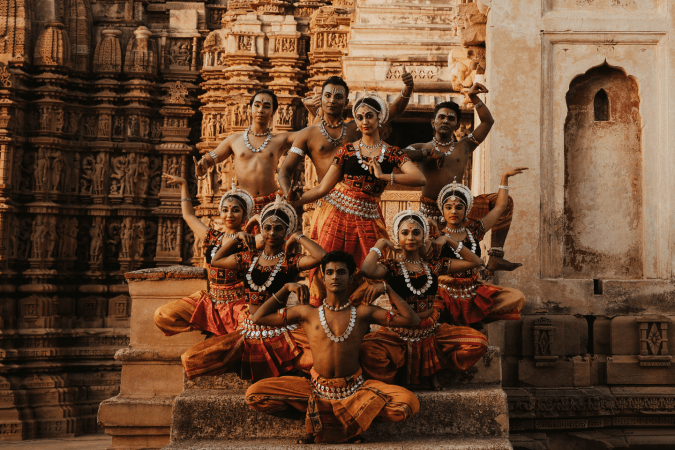
Khajuraho Dance Festival - © gather
Weather in Khajuraho Group of Monuments: Best Time to Visit
The Khajuraho Group of Monuments, located in the Chhatarpur district of Madhya Pradesh, India, experiences an extreme tropical climate with hot summers and mild winters.
Temperature
Khajuraho experiences significant seasonal temperature changes throughout the year.
- Summer (April to June): The weather can be extremely hot, with temperatures soaring up to 47°C (116.6°F). Daytime highs typically range between 32-34°C (90-93°F), making it a challenging time for outdoor activities.
- Monsoon (July to September): The monsoon season brings slightly cooler temperatures, with averages around 31-33°C (88-91°F), though the region does not receive heavy rainfall.
- Winter (November to February): Winters in Khajuraho are pleasant and cool, with nighttime lows dipping to 4°C (39.2°F) and daytime temperatures ranging from 29-33°C (84-91°F), offering comfortable weather for exploring.
Rainfall
Khajuraho is generally a dry region with minimal rainfall throughout the year. The monsoon season brings some showers in June and July, but the rain is typically light, and the rest of the year experiences very little precipitation.
Best Time to Visit
The ideal time to visit Khajuraho is between November and March, when the weather is mild and comfortable. During these months, temperatures range from 4-33°C (39-91°F), and rainfall is minimal, creating perfect conditions for exploring the city's famous temples and outdoor attractions.
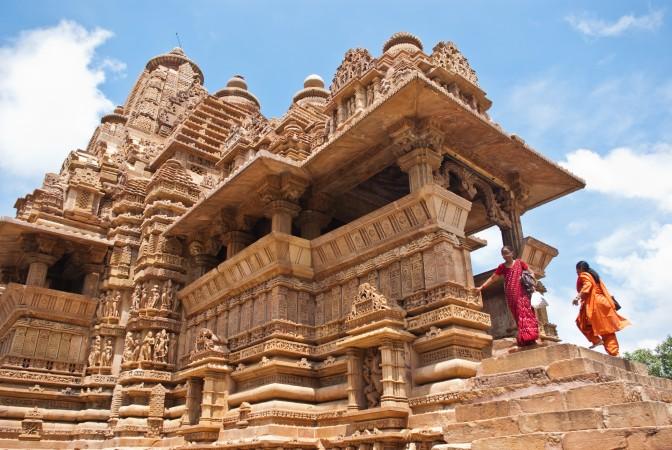
Lakshmana Temple - © gather
Culture Etiquette in Khajuraho Group of Monuments
Dress Modestly
You are encouraged to dress conservatively, especially when entering temples. Wearing clothing that covers your shoulders and knees shows respect for the religious significance of the sites and aligns with local customs.
Respect Sacred Spaces
Temples in Khajuraho are active places of worship, and maintaining a respectful demeanor is essential. Speak softly, avoid loud conversations, and refrain from disruptive behavior. Photography may be restricted in certain areas, so it’s crucial to look for signs and ask for permission when in doubt.
Remove Shoes
Before entering temple premises, you must remove your shoes. Designated areas for shoe storage are provided, and following this practice helps maintain the sanctity of these sacred spaces.
Engage with Locals Respectfully
The local population in Khajuraho is generally friendly and welcoming. When interacting with locals, it’s important to be polite and respectful. Engaging in conversations about their culture and traditions can be rewarding, but it’s advisable to avoid sensitive topics such as politics or religion unless initiated by them.
Participate in Rituals with Care
If you are invited to participate in local rituals or ceremonies, do so with respect and understanding. Observing the customs and following the lead of locals can enhance your experience, but asking questions if unsure about the process is recommended.
Photography Etiquette
While the intricate sculptures and architecture are captivating, it’s essential to ask for permission before photographing people, especially children. Some locals may have specific preferences regarding photography, so being considerate is key.
Support Local Artisans
Khajuraho is renowned for its handicrafts and local art. You are encouraged to purchase souvenirs from local artisans rather than mass-produced items. This not only supports the local economy but also helps preserve traditional crafts.
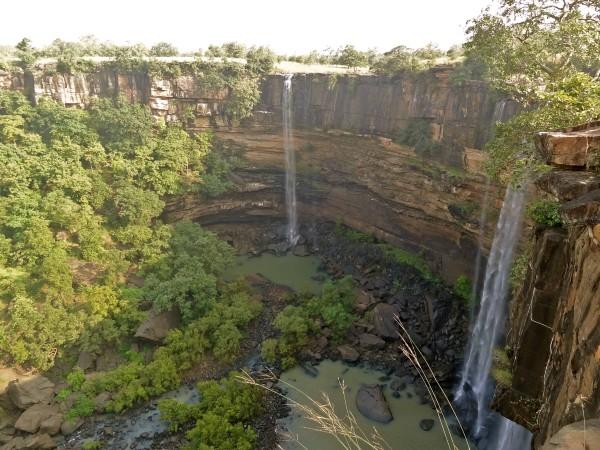
Panna National Park - © gather
Essential Travel Information
Getting to Khajuraho
By Air
- Khajuraho Airport (HJR) is located just 3 km from the monuments. It has regular flights from major Indian cities like Delhi, Mumbai, Varanasi, and Bhopal.
- Nearest International Airport: Varanasi Airport (VNS), about 390 km from Khajuraho. Flights from here connect to major international hubs.
By Train
Khajuraho Railway Station is located 9 km from the monuments. It has rail connectivity to cities like Delhi, Agra, and Varanasi.
By Road
- Khajuraho is well-connected by road from major cities in Madhya Pradesh and neighboring states. Regular bus services are available.
- Taxis and cabs can be hired for private transfers from nearby cities and airports.
Getting Around Khajuraho
- The Khajuraho Group of Monuments is spread over an area of about 6 sq km. The three main temple groups - Western, Eastern and Southern - are within walking distance of each other.
- Auto-rickshaws and taxis are readily available for short distances within the town. Fares are reasonable and can be negotiated.
- Bicycle rentals are a fun way to explore the monuments and surrounding areas at your own pace.
- Guided tours by car or bus are offered by travel companies for those who prefer a more organized experience.
- Within the monument complex, electric golf carts are available for those who need assistance getting around.
ATM and Banking Services
- ATMs: Khajuraho has several ATMs located throughout the town, making it easy for visitors to withdraw cash. Major banks such as State Bank of India, HDFC Bank, and Axis Bank have ATMs available.
- Banking Facilities: There are a few local banks in Khajuraho where travelers can exchange currency and access other banking services. However, it’s advisable to carry sufficient cash, especially when visiting remote areas or smaller shops, as not all establishments may accept credit or debit cards.
- Currency Exchange: Currency exchange services are available at some hotels and travel agencies, but it’s recommended to exchange currency at major banks or airports for better rates.
Accommodation Choices
Khajuraho offers a range of accommodation options to suit various budgets and preferences:
Luxury Hotels
- The Lalit Temple View Khajuraho: A five-star hotel offering luxurious amenities, stunning views of the temples, and fine dining options.
- Radisson Jass Hotel Khajuraho: Another upscale option featuring modern comforts, a swimming pool, and proximity to the monuments.
Mid-Range Hotels
- Hotel Chandela: A well-known hotel that provides comfortable rooms and is conveniently located near the temple complex.
- Hotel Khajuraho: Offers a blend of comfort and affordability, with easy access to local attractions.
Budget Accommodations
- Zostel Khajuraho: A popular choice among backpackers, this hostel offers dormitory-style accommodations and a vibrant social atmosphere.
- Hotel Harmony: An economical option that provides basic amenities and is located close to the temples.
Articles for you

Explore Yala National Park - Sri Lanka Travel, Asia
Tucked away in Sri Lanka’s southeastern corner, Yala National Park is where wild nature meets deep tradition. Known worldwide for its leopard population, the park is also home to elephants, sloth bears, crocodiles, and hundreds of bird species. Beyond wildlife, Yala opens doors to a cultural landscape dotted with ancient temples, Buddhist ruins, and coastal villages. For travelers seeking more than just a safari, Yala offers a chance to explore eco-tourism, local communities, and sacred heritage sites.
Population: The Yala National Park area doesn’t have a human population.
Economy: The economy around Yala National Park thrives on a blend of eco-tourism, agriculture, and local services. Safari tours, eco-lodges, and cultural experiences drive steady income for nearby towns like Tissamaharama and Kataragama, supporting thousands of families.
Landmarks: Famous for Block I of Yala and wildlife encounters, including elephants, sloth bears, crocodiles, and exotic bird species.

Explore Galle - Sri Lanka Travel, Asia
Nestled on Sri Lanka’s southern coastline, Galle is a vibrant city where history meets the sea. Its cobbled streets, colonial architecture, and serene beaches make it a must-visit destination for travelers seeking a blend of culture, adventure, and relaxation. A UNESCO World Heritage site, Galle captivates visitors with its Dutch Fort, bustling markets, and friendly locals. Whether you’re exploring the ramparts at sunset or savoring fresh seafood by the shore, Galle promises an unforgettable journey into Sri Lanka’s heritage.
Population: Approximately 113,000 in 2023.
Economy: Galle’s economy thrives on tourism, trade, and fisheries. The city’s historic fort, colonial architecture, and coastal charm draw thousands of international visitors each year, making tourism its main economic driver. Fishing remains vital for local livelihoods, supplying fresh seafood across the region.
Landmarks: Famous for the Galle Fort, Dutch Reformed Church & Maritime Museum, and Unawatuna Beach.

Explore Bentota - Sri Lanka Travel, Asia
Nestled along Sri Lanka’s southwestern coast, Bentota is a tropical paradise that blends golden beaches, vibrant culture, and thrilling adventures. Famous for its calm waters, luxury resorts, and scenic river estuary, Bentota has become a top destination for travelers seeking both relaxation and authentic experiences. From serene beach walks at sunrise to adrenaline-pumping water sports, this coastal town offers a perfect balance of leisure and exploration. With its proximity to Colombo and Galle, Bentota is easy to reach, making it an ideal stop for both short escapes and extended holidays.
Population: Approximately 37,000 in 2023.
Economy: Bentota’s economy thrives mainly on tourism, which drives local businesses such as hotels, restaurants, and wellness retreats. The town also benefits from fishing, coconut cultivation, and handicrafts like wood carving and batik textiles. Many residents rely on the growing demand for water sports and Ayurvedic treatments, making tourism the backbone of both income and employment in the area.
Landmarks: Famous for Bentota Beach, Bentota River Safari, and Kande Vihara Temple.

Explore Mirissa - Sri Lanka Travel, Asia
Mirissa is a charming coastal town on Sri Lanka’s southern shoreline. Known for its golden beaches, turquoise waters, and vibrant marine life, it has become a must-visit stop for travelers exploring the island. Many come for whale watching, surfing, and sunset views at Coconut Tree Hill, but Mirissa offers much more than postcard beauty. The fishing boats you see anchored by the bay carry generations of stories. Local traditions, delicious cuisine, and a laid-back rhythm of life shape every visitor’s experience.
Population: Approximately 4,700 in 2023.
Economy: Mirissa’s economy is largely shaped by its coastal location. Fishing has long been the backbone of local livelihoods, with generations relying on the Indian Ocean for income. In recent decades, tourism has become the main driver of growth, thanks to whale watching, surfing, and beachside hospitality.
Landmarks: Famous for Mirissa Beach, Coconut Tree Hill, and Parrot Rock Bridge.

Explore Nuwara Eliya - Sri Lanka Travel, Asia
Tucked away in the Central Highlands of Sri Lanka, Nuwara Eliya is often called “Little England”. With its rolling tea plantations, cool misty mornings, and colonial charm, this mountain town feels like a step into another world. Travelers come here to breathe fresh air, walk through flower gardens, sip the finest Ceylon Tea, and enjoy a pace of life far from the island’s busy cities. Whether you’re drawn by scenic landscapes, heritage architecture, or the warmth of its people, Nuwara Eliya is a destination that blends nature, culture, and history in perfect harmony.
Population: Approximately 781,000 in 2023.
Economy: Nuwara Eliya’s economy thrives mainly on tea production, as it sits in the heart of Sri Lanka’s central highlands, famous worldwide for Ceylon Tea. The city also benefits from a growing tourism industry, attracting visitors with its colonial charm, cool climate, and scenic landscapes.
Landmarks: Famous for Gregory Lake, Hakgala Botanical Garden, and Victoria Park.

Explore Sukau - Malaysia Travel, Asia
Nestled on the banks of the Kinabatangan River in Sabah, Malaysian Borneo, Sukau is a destination where wildlife, culture, and conservation come together. Known as one of Asia’s top spots for river safaris and eco-tourism, this quiet village offers a front-row seat to encounters with Bornean orangutans, pygmy elephants, proboscis monkeys, and exotic birdlife.
Population: Approximately 1,400 in 2019.
Economy: Sukau’s economy is shaped by its riverine location and natural resources. Traditionally, the Orang Sungai community relied on fishing, small-scale farming, and forest gathering for their livelihood. Today, the village has shifted toward eco-tourism, with river cruises, jungle trekking, and homestays providing income.
Landmarks: Famous for the Kinabatangan River cruises, Gomantong Caves, and Ox-bow lakes and wetlands.
